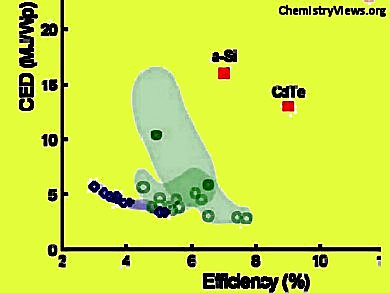Organic photovoltaics (OPVs) are expected to be a low cost, environmentally friendly energy solution with advantageous properties such as flexibility and light weight that enable their use in new applications. Considerable progress in power conversion efficiencies has brought OPV technology closer to commercialization. However, little consideration has been given to potential environmental impact associated with their production. An informative approach to evaluate this is through life-cycle assessment (LCA), the quantitative analysis of a product’s environmental impact from raw material extraction through production, use, and end-of-life management (cradle-to-grave).
Brian J. Landi, Rochester Institute of Technology, NY, USA, and colleagues calculated life cycle embodied energy for 15 new materials encompassing a variety of donor, acceptor, and interface compounds showing the most promise in organic electronics.
The cumulative energy demand (CED) required to fabricate small molecule and polymer photovoltaics were found to be similar from 2.9 to 5.7 MJ/Wp. This CED is on average of 50 % less than for conventional inorganic photovoltaics, motivating the continued development of both technologies.
The fullerenes used as acceptor material in OPV are the most energy-intensive material. They have a dramatic impact on polymer solar cells, comprising 18–30 % of the CED, despite only being present in small quantities. Increases in device efficiency are shown to marginally reduce CED for both small molecule and polymer designs.
Overall, the results can provide a framework to identify critical steps in the OPV life cycle where the greatest reduction in resource and emissions could be achieved.
- Cumulative energy demand for small molecule and polymer photovoltaics,
Annick Anctil, Callie W. Babbitt, Ryne P. Raffaelle, Brian J. Landi,
Prog. Photovolt: Res. Appl. 2012.
DOI: 10.1002/pip.2226




